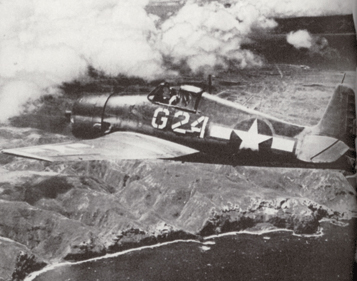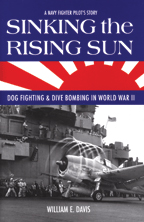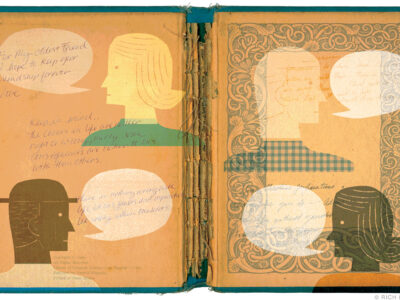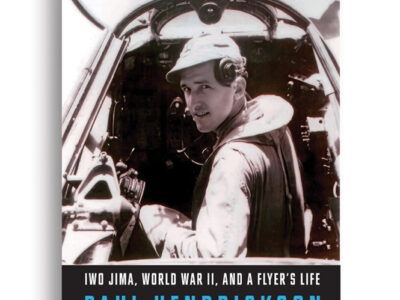
Class of ’42 | Many years ago, when he started taking his family on skiing trips, and they had driven far enough up into the Sierras that listening to the radio was out of the question, William E. Davis ME’42 began telling stories about his life as a Navy fighter pilot in World War II. And once he started, there was no turning back.
“Daddy, tell us war stories,” his two daughters would say, and he would oblige them with more tales of bombing and strafing and evading Japanese Zeros in his F6F Hellcat. And when, many stories later, he finally ran out, they’d say, “Tell them again.” And so he did—ripping tales of dogfights and sea rescues and losing buddies and carousing and … well, we’re not sure exactly which tales he told Diane and Wendy in the car, though we have a pretty good idea which ones he left out.
Fortunately, both varieties made it into his memoir, Sinking the Rising Sun: Dog Fighting & Dive Bombing in World War II, which was published last year by Zenith Press. (It was Diane who kept after him to put those stories to paper, and eventually he did.) While World War II memoirs aren’t exactly an unknown commodity, Davis has written a remarkably good one. He has, of course, some terrific raw material to work with—he was awarded the Navy Cross for his “extraordinary heroism” in sinking a Japanese carrier, to name just one feat—but he manages to make his flight training and booze-soaked R & R pretty entertaining, too. Turns out that the engineering student who never took a literature course at Penn had some real narrative skill and an eye for detail.
What surprised Davis was how hard it was to write about his wartime adventures. Harder, even, than it was to live through them—and Lord knows, that wasn’t easy. Take the daredevil landing he attempted at the Los Alamitos Air Station, when he hit some high-tension poles and cut two 230,000-volt power lines. “There was a blinding flash, followed by another one, then half of Southern California was blacked out,” he writes. “I was headed for the ground, hit, flipped over, and slid upside down until the plane came to a stop. By that time I was five feet under the ground, stunned.” Trapped upside down in a cockpit and expecting the half-buried plane to burst into flames at any moment, the first words he heard were: “How will we get the body out?”
Then there’s the citation accompanying his Navy Cross, which only hints at the dangers he faced when attacking the Zuikaku: “Flying through intense anti-aircraft fire, he made an aggressive attack on a Japanese carrier, first strafing and then delivering a well-placed bomb from low altitude.”
“I was not bothered particularly by being in combat,” said Davis in a recent telephone interview from his home in Santa Barbara, California. “I don’t understand that. Maybe a psychiatrist might have some insights. I never had nightmares or other things.
“But when I began writing this, it upset me quite a bit. I even had some flashes that I actually was killed. It was much more poignant when I was writing it than it was when I was doing it.”
He persevered, with the help of a diary he had kept during the war years. “Without that, I wouldn’t have been able to keep it all straight,” notes Davis, who had been a senior engineering student at Penn when the Japanese attacked Pearl Harbor. And the fact that he read a lot of books when he wasn’t flying or carousing undoubtedly contributed to his ability to spin a yarn on paper.
He admits to being pleasantly “stunned” by the positive reviews, and while he knows that the logistics and cost of making a film about a fighter pilot are daunting, he can’t resist noting that “virtually every reviewer says it screams out for a movie.”
—S.H.
EXCERPT
Sinking the Zuikaku—and Surviving

All I could see was the deck of that aircraft carrier.I cracked the throttle slightly so the engine wouldn’t stall, and let the plane fall. The response was instantaneous, as all of the anti-aircraft guns in the Japanese fleet opened up. They knew where I was going, and they didn’t have to lead me. They fired directly up over the carrier.
In moments, at 10,000 feet there was a black cloud of bursting shells from the 40-mm and 5-inch guns. It was so thick I couldn’t see through it. I knew I’d be dead in the next 30 seconds, but I also knew that if I had it to do over again, with all of the other alternatives I had, I’d be here now.
I flashed through the cloud, knowing it was filled with screaming metal from the explosions. I expected to feel the plane jolted any second, but I continued on. A second deadly cloud was forming at 4,000 feet from the exploding 20-mm shells. It was directly over the carrier, I had no choice but to fly through it.
Once again my luck held as I screamed down on the carrier, which now completely filled my gunsight. I rested my finger on the bomb-release button. I kept going. I wanted to make absolutely sure I got a hit. When it seemed I was going to hit the ship, I pushed the release and pulled out. I had not looked at my altimeter or air speed. I was way over the red line of the aircraft, and of course blacked out from the G forces on the pullout.
After a moment, I was conscious but couldn’t see. I heard a slight change in the pitch of the noise and eased forward on the stick. Blood instantly returned to my brain, and I could see again, and what I saw scared me to death. I was so low I was clipping the spray from the waves. I was also forty knots over the maximum speed for the plane. But the main thing was, I made it—until I looked up ahead. I was flying right into the side of the Oyodo, a Japanese heavy cruiser. I pulled back on the stick, and nothing happened. I couldn’t gain altitude. The elevator control must have been frozen due to the speed. Putting both hands on the stick and bracing myself against the rudder pedals, I pulled with all of my strength. The nose rose slightly, enough to clear the hull, but not enough to clear the superstructure. I was going to hit the ship. At the last moment I tried the aileron. It responded, and in that instant I rolled the plane on its right side and flew between the cruiser’s second gun turret and the bridge.
I was perhaps three feet from the windows on the bridge and could see the Japanese officers and enlisted men commanding the ship. There was an admiral in dress whites, complete with sword. The other officers and men were also in dress whites. I was going 530 miles an hour, and I only got a glimpse, but that image is impressed on my mind forever.
I quickly distanced myself from the ship and slowed to a reasonable speed. I made no effort to take evasive action, as I knew no one was paying special attention to me any longer. Somehow, my subconscious alerted me that I shouldn’t be flying in a straight line, regardless. At the speed I was going, it was painful to make a sharp turn, but I did. Moments later, there was a gigantic explosion where I would have been. That cruiser had turned one of its 8-inch gun turrets and fired at me. If I hadn’t taken evasive action, they would have hit me. I made another turn, with the same results. They were really determined. One more shot and I pulled up into a cloud, where I circled, then came down in another direction.
We had barely rendezvoused when Hugh called on the radio. “The carrier’s sinking, and they’re trying to take the admiral’s staff off on a cruiser. Go down and strafe it.”
We didn’t need a second invitation. We peeled off and dove on the Oyodo, which had pulled up at the stern of the carrier. Officers were jumping from the carrier to the forward deck of the cruiser. They were huddled together. We tore them to pieces. No one could have survived the fire from our machine guns. I only hoped this was the same staff that was aboard when they attacked Pearl Harbor.
From Sinking the Rising Sun: Dog Fighting & Dive Bombing in World War II, by William E. Davis ME’42. Copyright 2007 by William E. Davis. Reprinted by permission of Zenith Press.




